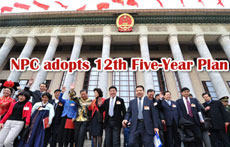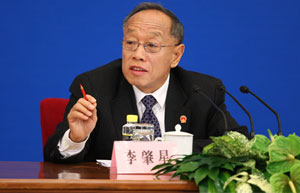Guangxi plans cross-border trade zone
By Huo Yan and Hu Yinan (China Daily)
Updated: 2011-03-15 07:47
Nanning - The Guangxi Zhuang autonomous region is seeking breakthroughs in the creation of an unprecedented cross-border economic cooperation zone with Vietnam in the next five years, its chairman, Ma Biao, has said.
The zone's formation was jointly agreed upon after Guangxi and Vietnam's northern province, Lang Son, signed a memorandum in January 2007. Guangxi expects the jointly managed zone to become an import-export processing center and a distribution depot with tax perks offered by both countries' customs.
China and Vietnam have also signed a similar framework agreement to establish a 10-sq-km cross-border economic zone between Dongxing, the only Chinese city with both land and sea borders with countries in the Association of Southeast Asian Nations (ASEAN) and Mong Cai city, northern Vietnam's largest border trade zone.
Both zones are parts of the free trade area between China and the ASEAN that took effect on Jan 1, 2010.
Tariffs are waived on 90 percent of products traded between China and ASEAN countries in the area, which is home to 1.9 billion people and boasts a combined GDP of $6 trillion. It is the world's third-largest free trade zone, after the European Union and the North American Free Trade Area.
This year marks the 20th year since China and the ASEAN established official relations, and Guangxi has remained a frontier of cooperation and exchanges. Last month, China's sixth and only bonded port on its western coast began operations in Qinzhou, a city in Guangxi with the closest bonded port to ASEAN countries.
The Pingxiang-Dong Dang economic zone is also a vital part of another ambitious project, the Nanning-Singapore Economic Corridor, said Zhao Leqin, Party chief of Chongzuo city, which administrates Pingxiang. The corridor, first proposed by Guangxi in 2006, starts from the autonomous region's capital city Nanning and traverses Vietnam, Laos, Cambodia, Thailand, Malaysia and Singapore.
A third regional cooperation platform in Guangxi is the Beibu Gulf Economic Zone, approved by the State Council in 2008. Ma, Guangxi's chairman, said the zone is expected to contribute more than 40 percent of the autonomous region's GDP by 2015.
Guangxi has planned 2,375 projects in the economic zone. These involve industry, ports, transportation, urban construction, logistics, tourism and culture. The projects will require a total investment of 2.6 trillion yuan between 2011 and 2015.
Guangxi is the most populous of China's five autonomous regions. About 60 percent of its 51 million residents are farmers, said its deputy chairman Chen Zhangliang.
Local authorities have vowed to urbanize half of the autonomous region by 2015, transforming at least 5 million farmers into urban dwellers.
Guangxi's current urbanization rate is 40.6 percent.
China Daily







